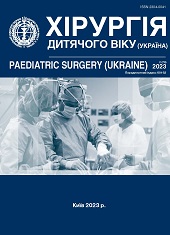Small intestinal obstruction by food in young children: a view on the problem, literature data and own clinical observations
DOI:
https://doi.org/10.15574/PS.2023.79.92Keywords:
obstructive obstruction of the small intestine, phytobezoar, food productsAbstract
Purpose - to improve the results of treatment of young children with small intestinal obstruction due to the introduction of informative imaging technologies and modern video treatment technologies; to present own clinical observations of food-related obstruction of the digestive tract in young children and their treatment.
The article provides a review of the literature on small intestinal obstruction caused by food in young children. Only four cases have been established. There are 2 cases of food obstruction (corn kernels, pineapple, red fish) in children under 3 years of age. Based on my own experience, the use of the term «phytobezoar» in the treatment of small intestinal obstruction is substantiated. All underwent surgical treatment: 1 - laparotomy, 1 - laparoscopic. All children recovered and were discharged from the clinic.
The diagnosis and verification of food-related intestinal obstruction in young children is primarily based on the results of a thorough history. It is advisable to use the following methods in order to verify the location of the obstruction and establish the factor: X-ray examination of the organs of the abdominal cavity, both during hospitalization and during the course of the disease, CT scan, as well as ultrasound of the abdominal cavity. The presence of doubts in determining the cause of small intestinal obstruction is an indication for diagnostic laparoscopy. The interpretation of the term phytobezoar should have a basis, taking into account the time of obstruction and stay of the product in the digestive system, conditions and types of food.
The study was conducted in accordance with the principles of the Declaration of Helsinki. Informed consent from the child’s parents was obtained for the research.
No conflict of interests was declared by the authors.
References
Ali AYu, Biyikli A, Mohamed AA, Dhaley A, İbrahim İG. (2022, Apr). Infrequent cause of small bowel obstruction in a child: A lemon. Ann Med Surg (Lond). 76: 103488. Published online 2022 Mar 15. https://doi.org/10.1016/j.amsu.2022.103488
Glatstein M, Danino D, Rimon A, Keidar S, Scolnik D. (2013). An unusual cause of small bowel obstruction in a child: ingested rhubarb. Case Rep. Surg. 2013: 497214. https://doi.org/10.1155/2013/497214; PMid:23878756 PMCid:PMC3708412
Konoplitskyi VS, Dmytriiev DV, Kalinchuk OO, Konoplitskyi DV, Blazhko SS. (2019). Bezoarna khvoroba shlunkovo-kyshkovoho traktu u ditei (ohliad literatury ta interpretatsiia klinichnoho sposterezhennia. Journal of Perioperative Medicine / Clinical thinking. 2; 1: 52-58. https://doi.org/10.31636/prmd.v2i2.7
Patcharu R, Chand K, Parikh B. (2021). Phytobezoar causing intestinal obstruction in a neonate: a case report. J. Neonatal Surg. 10: 3. URL: https://www.jneonatalsurg.com/ojs/index.php/jns/article/view/704. https://doi.org/10.47338/jns.v10.704
Raveenthiran V, Surg IJ. (2009. Feb). An Unusual Association of Gastroduodenal Phytobezoar and Malrotation of the Midgut. Indian J Surg. 71 (1): 38-40. Epub 2009 Mar 13. https://doi.org/10.1007/s12262-009-0009-4; PMid:23133107 PMCid:PMC3452568
Rusak PS, Rybalchenko VF, Vyshpinska VM, Melnyk BA, Talko MO. (2013). Hihantskyi trykhobezoar shlunka ta dvanadtsiatypaloi kyshky u divchynky 15 rokiv. Khirurhiia dytiachoho viku. 2: 77-80.
Rusak PS. (2011). Innovatsiini tekhnolohii v diahnostytsi, likuvanni ta profilaktytsi urhentnoi khirurhichnoi abdominalnoi patolohii u ditei. Avtoref. dys. na zdobuttia naukovoho stupenia doktora medychnykh nauk. Kyiv: 32.
Rybalchenko VF. (2013). Analiz roboty dytiachoi khirurhichnoi sluzhby Ukrainy u 2012 rotsi. Khirurhiia dytiachoho viku. 3: 24-33.
Yurchenko MI, Rybalchenko VF. (2005). Bezoary travnoho kanalu u ditei. Khirurhiia dytiachoho viku. 2: 93-96.
Downloads
Published
Issue
Section
License
Copyright (c) 2023 Paediatric Surgery (Ukraine)

This work is licensed under a Creative Commons Attribution-NonCommercial 4.0 International License.
The policy of the Journal “PAEDIATRIC SURGERY. UKRAINE” is compatible with the vast majority of funders' of open access and self-archiving policies. The journal provides immediate open access route being convinced that everyone – not only scientists - can benefit from research results, and publishes articles exclusively under open access distribution, with a Creative Commons Attribution-Noncommercial 4.0 international license(СС BY-NC).
Authors transfer the copyright to the Journal “PAEDIATRIC SURGERY.UKRAINE” when the manuscript is accepted for publication. Authors declare that this manuscript has not been published nor is under simultaneous consideration for publication elsewhere. After publication, the articles become freely available on-line to the public.
Readers have the right to use, distribute, and reproduce articles in any medium, provided the articles and the journal are properly cited.
The use of published materials for commercial purposes is strongly prohibited.

